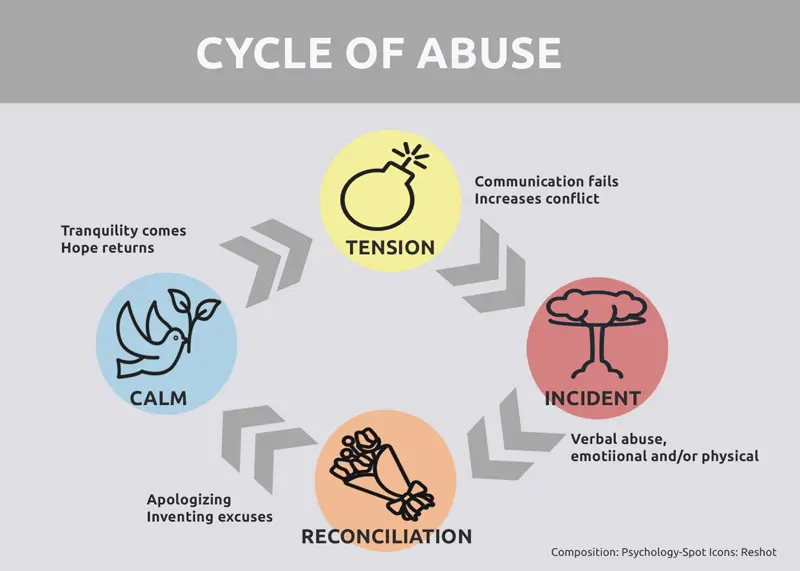
Verbal abuse does not leave physical traces, but its psychological marks are very deep. A phrase, said at a time when we are especially vulnerable, can remain imprinted with fire in our minds, activating again and again. Words have incredible power. They can calm and empower us, but they can also hurt and break us down.
Coexistence generates disagreements that leave us with emotions on edge. To some extent, conflicts are positive as they represent opportunities for change. However, when the fight escalates and words become offensive, occurs a situation of verbal violence. And “Violence, whatever form it manifests itself, is always a failure,” in the words of Jean Paul Sartre.
What is verbal violence?
Sometimes, in the middle of a heated argument, emotions take over and anger or frustration can cause us to say hurtful things. It is understandable that in some circumstances we lose our composure, but if it becomes the norm, we are facing a situation of verbal abuse.
Verbal violence is a form of destructive communication in which one person harms another. It is a communicative pattern sustained over time in which, more or less intentionally, continuous verbal abuse is carried out that affects the victim’s self-esteem, causing a negative emotional state and generating doubts about their worth as a person.
And it should be noted that it does not only occur within a relationship or family, it is also common in toxic work environments, whether between work colleagues or, what is more common, by those who hold a position of power.
What is the difference between verbal abuse and a heated argument?
It is not easy to distinguish a heated argument from verbal abuse. In fact, many people are not even fully aware that they are victims of verbal abuse. Victims often downplay what is happening or try to justify the other’s behavior by thinking things like “he didn’t really mean that” or “he said it in a moment of rage, I shouldn’t pay attention to it.”
It must be clear that, if in a heated discussion one of the people insults, humiliates and/or blames the other, verbal aggression is occurring. However, a specific situation does not imply that a dynamic of verbal violence has been established in the relationship. This occurs when there is a recurring pattern; That is, when shouting, insults, threats and humiliation are continually used to subdue the other.
Therefore, although the ideal is to avoid words that could harm the others, verbal abuse occurs when it becomes the norm. Although we must be aware that this “norm” does not imply that it occurs every day at all hours. In fact, verbal violence, like other types of abuse, usually follow a cycle.
The cycle of verbal violence that perpetuates it
In 1979, psychologist Lenore E. Walker interviewed about 1,500 women who had been victims of domestic violence and found a similar pattern, which she called the “cycle of abuse.” At first she proposed three phases, but later these were expanded to include a fourth that allows us to better understand the dynamics of abuse:

• Tension generation
The obligations of daily life, such as conflicts in raising children, relationship problems, disagreements with families of origin, economic difficulties or simply misunderstandings, generate tension that accumulates. During this phase, the abuser feels upset or even ignored, threatened or humiliated in some way.
However, lacking the appropriate psychological tools to release these tensions, he accumulates them inside for days or sometimes even months. He spins what is happening in his mind and creates narratives in which he blames the other person for all his problems, which begins to generate a feeling of animosity.
• Incident
It can be a one-off verbal outburst during an argument, but it can also go on for days. In this phase, the abuser tries to dominate and manipulate his victim by making her feel bad. Practically everything bothers him and any excuse is good to start a dispute, so the victim feels like walking on fragile glass that is about to break. By releasing the retained psychological energy, the abuser reduces internal tension, so he may even think that the victim “deserved it.”
• Reconciliation
At this point, the abuser may understand that he has crossed boundaries and may even fear that the person will abandon him. Therefore, it is common for him to begin to feel remorse or experience guilt. Instead, the victim may feel confused, esteemed, humiliated or even afraid or thinking that she is responsible for what happened.
The abuser will try to apologize and win back the victim’s affection, often promising that it will not happen again and showing her regret and sadness. He will probably do everything to regain that person’s trust. In some cases he may even try to downplay what happened by stating that “it wasn’t that big of a deal”, that “it happens to everyone” or that the other “made him crazy”.
For her part, the victim, who often just wants the relationship to improve and also feels emotionally exhausted, may be willing to ignore what happened, forgive him, and start a clean slate in order to leave behind the nightmare she was living.
• Calm
During this stage of the cycle of violence, which many call the honeymoon, the relationship returns to being relatively calm and serene. The abuser may even try to make things go back to normal and make the other person feel good, perhaps by buying them gifts or making compliments.
In this way, the victim fosters hope that the abuse has ended and trusts the other again. She can even adopt a more submissive and dependent posture, thinking that in this way she will not give rise to abuse, which implies that deep down she blames herself for what happens.
It is precisely these oscillations between abuse and gratification that underpin the abusive relationship since the victim keeps alive the illusion that the other will change. However, when problems are not addressed head-on but rather ignored, they end up becoming an elephant in the room. Consequently, it is not uncommon for everyday tensions and latent conflicts to resurface and the abuse to be perpetuated.
7 signs of verbal abuse: Beyond screams and insults
1.Insults and screams
Insults and shouts are the most obvious expression of verbal abuse. In this case, the person raises continually his voice to try impose himself and doesn’t hesitate to resort to insults and offenses to try to control you instilling fear. As the writer John Frederick Boyes pointed out: “Violence in the voice is often the death of reason in the throat”.
2. Humiliation and destructive criticism
There is a more subtle but very harmful kind of verbal abuse: humiliation and destructive criticism. In this case, the person doesn’t resort to shouting but to sarcasm, shame, disdainful gestures and degradation to exert control. He can use jokes that make you feel bad or words and gestures that belittle you and/or make you feel incompetent.
3. Accusations and guilt trip
In some cases, verbal abuse hides manipulation. The person will make you responsible for all the bad things that happen, shedding his share of responsibility to make you feel bad. That person won’t hesitate to accuse you and make you feel guilty, always blaming you bad intentions or total incompetence.
4. Trivialize
This type of verbal abuse is more subtle and difficult to detect since it consists of downplaying your opinions and feelings, to the point of making you feel that you’re completely insignificant. That person doesn’t show empathy, he’s continually minimizing your problems and even refusing to address them.
5. Threats
In addition to the typical threats through which a person tries to control your behavior, there are also threats that resort to emotional blackmail. One of the most extreme examples is: “If you leave me, I kill myself”, but there are many other forms of threats and extortion in all kinds of relationships.
6. Cosification
In this case, there are usually no insults or shouting, the person simply treats you as if you were an object, which means that he doesn’t pay attention to you or satisfy your emotional needs. That person systematically ignores you, pretending you don’t exist.
7. Blocking the dialogue
We usually identify verbal aggression with shouting and insults, but also silence can be used as a weapon to cause deep wounds. Not talking to a person, with the aim of making him feel bad, preventing dialogue that can solve the conflicts that exist in the relationship, is a form of verbal violence.
The consequences of verbal violence affect your brain and health
The fact that they shout, humiliate or ignore us or our affective needs often ends up changing our mind, brain and even our body. When a fear response is triggered repeatedly due to a hostile environment, such as one marked by shouting or emotional coldness, occur physical and emotional reactions automatic that can cause a psychological trauma. In fact, it’s not unusual for those who have been victims of verbal abuse for years to end up suffering from depression or anxiety.
In addition, verbal violence increases the activity of the amygdala, so that it becomes more reactive and keeps us in a state of constant nervous excitement. It also increases the production of stress hormones and generates muscle tension, which means that it will have negative repercussions on our health in the medium and long term, triggering diseases that have a psychosomatic component.
Verbal abuse also ends up changing what we think and how we feel about ourselves. This is because the neural connections established in our brain depend to a large extent on our experiences. And if those experiences are marked by verbal abuse, it’s difficult to escape from them. In other words: if someone makes us feel that we’re worthless, we are likely to end up believing it.
Research on attachment and motherhood confirms what we all intuitively know: as human beings, we feel better when we’re loved and safe, which means, among other things, receiving a respectful treatment.
How to stop the verbal abuse?
If you’re being victim of verbal aggressions, it’s important that you stop it as soon as possible. Stopping verbal violence is an act of self-defense and self-love, because in the long run that situation will end up damaging your self-esteem deeply and will charge a very high bill on your health.
You have to establish limits, red lines that the other person must not exceed. Make it clear to him that you are not willing to endure certain behaviors.
Since some people are not fully aware of the impact of their words, a good starting point is to make them notice how much their words and attitudes hurt you. In this way you will get them out of their egocentric position and put them in your place.
You can also offer your help to find a solution together. Verbal abuse can be the expression of mental breakdown, the inability to adopt a more assertive relational style or even fear. Finally, as psychologist Marshall Rosenberg said: “All violence is the result of people tricking themselves into believing that their pain derives from other people and that consequently those people deserve to be punished.” The important thing is that the persons recognize they need help to deal with conflicts and relationships in a more constructive and enriching way.
As a last chance, if these strategies don’t work, because it’s not always in our hands to change the other person, we always have the option of getting away from that person who is hurting us.




Leave a Reply